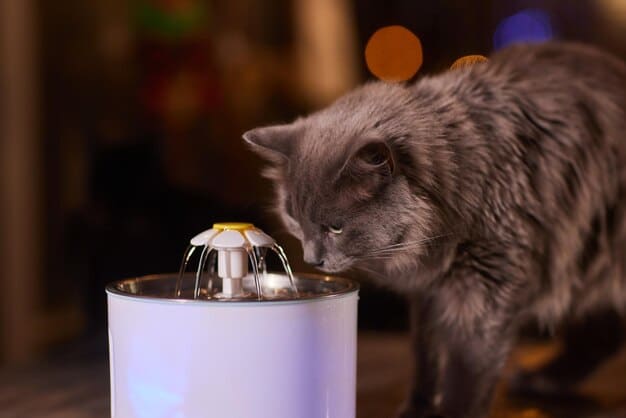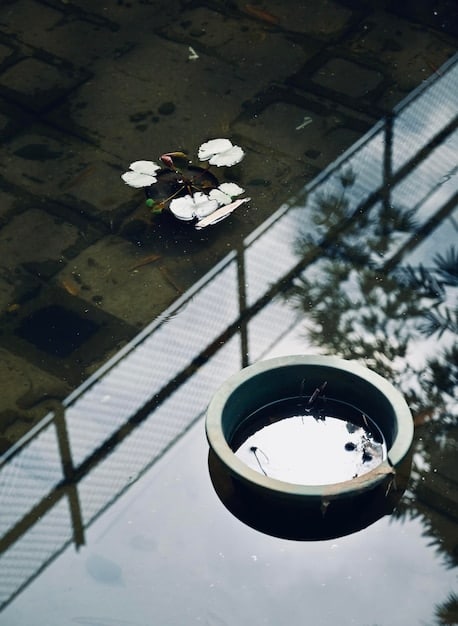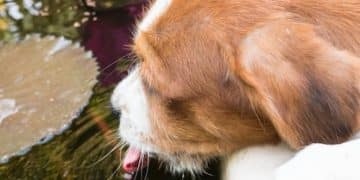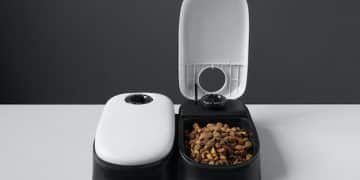Are Automatic Pet Water Fountains Worth It? Top Brands Reviewed

Automatic pet water fountains offer a continuous supply of fresh, filtered water, potentially improving pet health and reducing owner effort, but their value depends on pet needs, maintenance requirements, and fountain quality from top brands.
Are automatic pet water fountains worth it? A review of top brands can help you decide if investing in one of these devices is the right choice for your furry friend’s health and hydration.
Automatic Pet Water Fountains: An Overview
Automatic pet water fountains have gained popularity in recent years as a convenient way to provide pets with fresh, clean water. But how do they work and what are their key features?
These devices typically consist of a reservoir, a pump, and a filtration system. The pump circulates the water, while the filter removes impurities and odors, ensuring that your pet always has access to appealing and healthy drinking water.
How Automatic Fountains Work
The core concept behind an automatic pet water fountain is simple yet effective. A small electric pump continuously circulates water from a reservoir through a filter and back into a drinking area, often a bowl or spout.
This constant circulation prevents stagnation and keeps the water cooler, making it more enticing for pets to drink. Many fountains also feature multi-stage filtration systems to remove debris, sediment, and even odors, ensuring that your pet gets cleaner water compared to a regular bowl.
- Constant Circulation: Prevents water from becoming stale.
- Filtration: Removes impurities like food particles and hair.
- Cooler Water: More appealing, especially to cats and small dogs.

Benefits of Using a Pet Fountain
The benefits of using an automatic pet water fountain extend beyond just convenience. Proper hydration is crucial for your pet’s health, and a fountain can encourage them to drink more.
The flowing water is often more attractive to pets, especially cats who are instinctively drawn to moving water sources. This can help prevent dehydration-related health issues, such as urinary tract infections and kidney problems. Additionally, the filtration system can remove harmful substances like chlorine and heavy metals.
In summary, automatic pet water fountains offer convenience, encourage hydration, and provide cleaner water, all of which contribute to your pet’s improved well-being.
Top Brands in Automatic Pet Water Fountains
With the popularity of automatic pet water fountains, numerous brands have emerged, each offering unique features and designs. Understanding the top brands can help consumers make an informed decision.
Some of the leading brands include PetSafe, Drinkwell, Pioneer Pet, and Catit. Each brand offers a range of fountains, from basic models to more advanced options with features like UV sterilization and wireless operation. It’s important to consider the specific needs of your pet when choosing a brand and model.
- PetSafe: Known for durable and innovative designs.
- Drinkwell: Offers a variety of fountain styles and sizes.
- Pioneer Pet: Specializes in ceramic fountains for hygiene and aesthetics.
- Catit: Provides affordable and accessible options for cat owners.
Choosing the right brand often comes down to a balance of features, price, and customer reviews. Each of these top brands has its strengths, and it’s worth researching each one to find the best fit for you and your pet.
Factors to Consider When Choosing a Fountain
Selecting the right automatic pet water fountain involves several considerations to ensure it meets your pet’s needs and fits your lifestyle. What factors should you keep in mind during the selection process?
Consider the size and breed of your pet, the fountain’s capacity, the ease of cleaning, and the type of filtration system. Noise level can also be important, especially if the fountain is located in a bedroom or living area. Cost is another factor, but don’t compromise on quality for a lower price, as a more durable fountain will save you money in the long run.
Size and Capacity
Pet size and water consumption habits are critical in determining adequate capacity. A larger breed consuming a lot more water will require a fountain with a larger reservoir, for example.
Smaller pets may do just fine with compact versions, but larger dogs or multi-pet households will necessitate a high-capacity dispenser that minimizes refilling frequency. Also consider your pet’s drinking habits – playful pets may splash water, so a deeper bowl might be preferential.
Material and Cleaning
The fountain’s material also affects its ease of cleaning and maintenance. Stainless steel and ceramic fountains are generally easier to clean and more hygienic than plastic versions.
Consider a model with dishwasher-safe components for effortless maintenance. Regularly cleaning your pet’s water fountain prevents bacterial growth and ensures continually fresh water. Look for designs that are easy to disassemble and reassemble for swift cleanup.
When choosing an automatic pet water fountain, consider size, water capacity, material, and cleaning requirements to make the best choice for your animal.
Pros and Cons of Automatic Pet Water Fountains
Like any pet product, automatic water fountains have upsides and downsides. What are the main benefits and drawbacks to using these devices?
The primary pros include improved hydration, cleaner water, and convenience. However, some cons are the initial cost, the need for regular cleaning and filter replacements, and the potential for mechanical issues. Weighing these pros and cons can help you decide if a fountain is the right choice for your pet.
Advantages of Pet Water Fountains
The advantages of automatic pet water fountains are numerous and impactful for your pet’s health and well-being. Proper and convenient hydration are central benefits.
Flowing water appeals to many animals, especially cats, incentivizing them to drink more often. Clean, filtered water eliminates sediments and odors, further encouraging pets to stay hydrated. Convenient automatic dispensing reduces the need for daily bowl refills.
Disadvantages and Potential Issues
Despite their benefits, automatic water fountains also have potential drawbacks and possible challenges. These include the initial cost of the unit and the need for ongoing maintenance.
Fountains require regular cleaning to prevent bacterial growth and filter replacements, which add to the long-term expenses. Moreover, mechanical issues such as pump failures can occur, requiring troubleshooting or replacement. Not all pets instantly adapt to drinking from a fountain, so patience and encouragement may be needed.

In conclusion, automatic pet water fountains offer several advantages, but being aware of potential downsides and maintenance requirements allows pet owners to have a more informed perspective of pros versus cons.
Maintenance and Cleaning Tips
To keep your automatic pet water fountain working efficiently and hygienically, regular maintenance and cleaning are crucial. What are some essential maintenance practices?
Start by cleaning the fountain at least once a week. Disassemble all components, rinse them thoroughly, and use a mild soap to scrub away any buildup. Replace the filter according to the manufacturer’s instructions, typically every 2-4 weeks. Check the pump regularly for debris and ensure it’s functioning properly.
Cleaning Frequency
Consistent cleaning is the key to a healthy pet water fountain. How often should the fountain be serviced and refreshed?
Plan to deep-clean your automatic pet water fountain at least once a week, or more frequently if you notice any visible debris or algae growth. Regular cleaning disrupts bacteria and keeps the water fresh. Empty and refill the fountain with clean, filtered water every couple of days to keep the water tasting its best.
Filter Replacement
The filter plays a vital role in ensuring that your pet’s water is clean and free of impurities. When should you replace it?
Filter replacement frequency depends on the type of filter and manufacturer guidelines. Activated carbon filters typically need replacing every 2-4 weeks, while sponge filters last a little longer. Staying on a consistent filter replacement schedule safeguards your pet by efficiently removing contaminants.
Regular maintenance, timely filter replacements, and consistent cleaning will keep your automatic pet water fountain clean, safe, and inviting for your animal.
Are Automatic Pet Water Fountains Worth It? Real-World Experiences
Understanding real-world experiences can provide further insight into the value of automatic pet water fountains. What do actual users say about these products?
Many pet owners report that their pets drink more water when using a fountain. They also appreciate the convenience of not having to refill the water bowl as often. Some users have noted that their pets’ health improved after switching to a fountain, particularly in cases of urinary issues. However, some users have also experienced issues with noise or mechanical failures.
- Increased Water Consumption: Pets are often more attracted to flowing water.
- Convenience: Reduces the frequency of refills.
- Improved Health: Especially beneficial for pets with urinary issues.
Overall, most users find that the benefits of automatic pet water fountains outweigh the drawbacks. However, it’s important to choose a high-quality fountain and maintain it properly to ensure optimal performance.
Ultimately, deciding whether to invest in an automatic pet water fountain falls to assessing your pet’s unique needs, water intake habits, and any existing health challenges. Positive feedback from pet owners reinforces the value and benefits of these products.
| Key Point | Brief Description |
|---|---|
| 💧 Hydration | Encourages pets to drink more, improving overall health. |
| ✅ Cleanliness | Filters remove impurities, providing fresher water. |
| ⏰ Convenience | Reduces the need for frequent water bowl refills. |
| 💰 Cost | Initial investment and upkeep with filters and maintenance. |
Frequently Asked Questions
▼
While most pets can enjoy and benefit from water fountains, it’s essential to consider your pet’s size, breed, and any specific health conditions. Some pets may take time to adjust to using a fountain.
▼
It is recommended to clean your pet water fountain thoroughly at least once a week. This prevents bacterial growth and keeps the water fresh, ensuring your pet’s health and safety.
▼
Filter replacement frequency depends on the type of filter and the manufacturer’s guidelines, but as a general rule, most filters should be replaced every 2-4 weeks to maintain optimal water quality.
▼
The noise level of pet water fountains can vary. Some models operate very quietly, while others may produce a gurgling or humming noise, which could be disruptive to some owners or pets.
▼
Yes, pet water fountains can help with urinary issues. By encouraging pets to drink more, they can help dilute urine and reduce the risk of urinary tract infections and kidney problems.
Conclusion
In conclusion, automatic pet water fountains can be a worthwhile investment for pet owners looking to improve their pet’s hydration and overall health. By providing fresh, filtered water, these fountains encourage pets to drink more and can help prevent health issues related to dehydration. While there are some drawbacks, such as the initial cost and the need for regular maintenance, the benefits often outweigh the costs for many pet owners.





